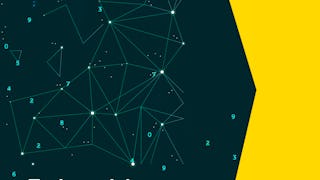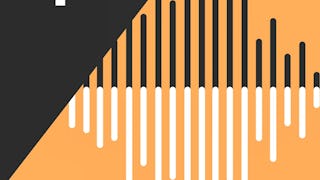Welcome to the Econometrics - Theory and Practice course! By the end of this course, you will understand the statistical tools required to comprehend empirical economic research and plan and conduct your independent research projects. This course introduces you to econometric model formulation, estimation of the chosen model using quantitative data, testing hypotheses about the phenomenon under study, post-estimation diagnostics to see how well the model performs, and the commonly encountered problems, such as multicollinearity, heteroscedasticity, autocorrelation, and model specification errors. It builds on the research awareness and skills developed in the quantitative and qualitative analysis courses covered earlier in the program. Major topics in econometrics will be covered from the point of view of their real-world applications.



Expérience recommandée
Ce que vous apprendrez
Define the assumptions and algebraic properties of the OLS estimators, interpret the findings, and draw their statistical inferences.
Detect issues of omitted variable bias, multicollinearity, heteroscedasticity, autocorrelation, and assess the performance of an econometric model.
Formulate an econometric model with one dependent and multiple independent variables, and apply the methods to analyze actual data using Stata.
Compétences que vous acquerrez
- Catégorie : Statistical Methods
- Catégorie : Statistical Analysis
- Catégorie : Econometrics
- Catégorie : Statistical Hypothesis Testing
- Catégorie : Statistical Modeling
- Catégorie : Probability Distribution
- Catégorie : Time Series Analysis and Forecasting
- Catégorie : Data Manipulation
- Catégorie : Regression Analysis
- Catégorie : Probability & Statistics
- Catégorie : Quantitative Research
- Catégorie : Stata
- Catégorie : Statistical Inference
- Catégorie : Correlation Analysis
Détails à connaître
28 devoirs
Découvrez comment les employés des entreprises prestigieuses maîtrisent des compétences recherchées

Il y a 8 modules dans ce cours
In this module, you will learn about the scope of econometrics, economic models, and econometric models. You will then be introduced to regression analysis between one dependent variable and one independent variable. Further, you will revise the concepts of individual, conditional, and joint distributions and the concept of variable independence. Later, you will learn how to identify relationships between two variables. And lastly, you will explore the general nature of the linear regression model.
Inclus
11 vidéos6 lectures3 devoirs
In this module, you will learn about the theory and practice of simple linear regression with one dependent variable and one independent variable. Simple linear regression is a statistical method that allows us to summarize and study relationships between two variables and goes beyond exploring the simple correlation between them. You will first learn the estimation and interpretation of the estimators of a regression model. Then, you will be able to understand those estimators’ numerical and statistical properties. Lastly, you will work with some practical, functional forms to handle nonlinearities in regression models.
Inclus
13 vidéos5 lectures3 devoirs1 sujet de discussion
In this module, you will move from the simple linear regression model with one regressor to the multiple linear regression model with two or more regressors. We use the adjective “simple” to denote that a model has only one regressor and the adjective “multiple” to indicate that a model has at least two regressors. In learning the practice of multiple linear regression, importance is accorded to building an intuitive understanding without using matrix algebra, mainly by analogy with simple linear regression. Lastly, you can derive and learn the algebraic properties of a regression model with k explanatory variables.
Inclus
12 vidéos5 lectures3 devoirs1 sujet de discussion
In this module, you will continue with the multiple linear regression model and use that to learn statistical inference, allowing you to infer something about the population model from a random sample. The sixth assumption of the classical linear model is the additional assumption that the population error is normally distributed. In the model, you will understand the sample distributions of the OLS estimators. Further, you will be able to review how to carry out a hypothesis test, assuming the six assumptions are true. You will also be able to do several specifications of hypothesis testing, including restrictions on a single parameter, a combination of two parameters, exclusion restrictions, tests of overall significance, and multiple linear restrictions. To conclude, you will be using the t-statistic and F-statistic.
Inclus
14 vidéos7 lectures5 devoirs1 sujet de discussion
In this module, you will continue with the multiple linear regression model and explore the asymptotic properties of the OLS estimators, which holds true when you transition from a small sample to a large sample. These properties are also known as the large sample properties. Post OLS asymptotics, you will learn about some extensions of the linear regression model, which are mostly used in applied work. You will further explore regression models, which are three different functional forms of explanatory models. Starting with the case when you have quadratic terms of the explanatory variable, you will discuss regression models with categorical explanatory variables. Finally, you will understand the regression models involving the interaction of explanatory variables as regressors.
Inclus
10 vidéos7 lectures5 devoirs1 sujet de discussion
In this module, you will keep using the multiple linear regression model and analyze the standard linear regression model considering the three problems that crop up most frequently when analyzing cross-sectional data. You will learn, in particular, about the bias and inconsistency arising from omitting important variables, as well as the effects of multicollinearity and heteroscedasticity in your data. You will also learn how to identify multicollinearity and heteroscedasticity in your model, test for it, and correct it using various techniques.
Inclus
10 vidéos6 lectures4 devoirs1 sujet de discussion
In this module, you will learn about data and specification errors commonly encountered in multiple linear models. You will also learn about the tests to check for model misspecification, using proxy as a possible solution for model misspecification. Further, you will be introduced to issues that crop due to measurement error in the dependent and independent variables. You will also gain an understanding of two advanced models. First is the binary response model, which is used when the dependent variable is binary in nature. Next, you will learn about the time series model. You will also get some insights into the problem of autocorrelation, which is usually encountered when we have specification errors in time series data.
Inclus
13 vidéos6 lectures4 devoirs
This module describes the learning objectives, project brief, review criteria, grading criteria, and submission instructions for the end-term Staff Graded Assignment for the course.
Inclus
1 vidéo2 lectures1 devoir
Obtenez un certificat professionnel
Ajoutez ce titre à votre profil LinkedIn, à votre curriculum vitae ou à votre CV. Partagez-le sur les médias sociaux et dans votre évaluation des performances.
Instructeur

Offert par
En savoir plus sur Economics

Erasmus University Rotterdam
 Statut : Essai gratuit
Statut : Essai gratuitRice University
 Statut : Gratuit
Statut : GratuitErasmus University Rotterdam
Pour quelles raisons les étudiants sur Coursera nous choisissent-ils pour leur carrière ?





Ouvrez de nouvelles portes avec Coursera Plus
Accès illimité à 10,000+ cours de niveau international, projets pratiques et programmes de certification prêts à l'emploi - tous inclus dans votre abonnement.
Faites progresser votre carrière avec un diplôme en ligne
Obtenez un diplôme auprès d’universités de renommée mondiale - 100 % en ligne
Rejoignez plus de 3 400 entreprises mondiales qui ont choisi Coursera pour les affaires
Améliorez les compétences de vos employés pour exceller dans l’économie numérique
Foire Aux Questions
Access to lectures and assignments depends on your type of enrollment. If you take a course in audit mode, you will be able to see most course materials for free. To access graded assignments and to earn a Certificate, you will need to purchase the Certificate experience, during or after your audit. If you don't see the audit option:
The course may not offer an audit option. You can try a Free Trial instead, or apply for Financial Aid.
The course may offer 'Full Course, No Certificate' instead. This option lets you see all course materials, submit required assessments, and get a final grade. This also means that you will not be able to purchase a Certificate experience.


